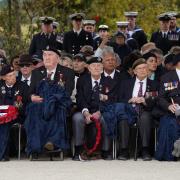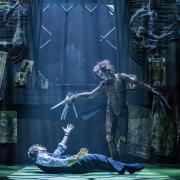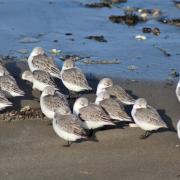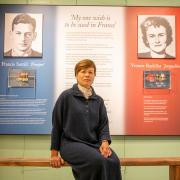Eileen Cooper’s ability to use colour alongside her attention grabbing artwork saw her recently awarded an Honorary Doctorate says Sandra Smith

To create an image which captures a moment is surely the essence of any artist’s objective. To concurrently invite the viewer into an ongoing scene, encouraging them to become an integral part of a depicted situation, either via the close witnessing of events or playing a role, if only as a bystander, is an enviable skill and one which makes Eileen Cooper’s work so distinctive.
I’ve no doubt part of my appreciation of her representations is due to the boldness of this artist’s choice of colours. Strong tones always draw me in. They inform, make a statement and defy anyone to disregard them.
“A teacher once told me I had an ability to use colour,” Eileen recalls. “I have always bought beautiful materials – lovely colours that will stand alone or mix. I want chromatic intensity in my work.”
Important as this initial attraction is, her paintings embrace fluidity, too. I sense movement in her pieces. And where there is movement, there is ongoing activity and interest.
Let me give you an example: in Spring Fever a man effortlessly lifts a woman in celebration of the season. Yet there is much more in the background and more potential to this oil painting. A number of birds are actively involved in the scene and a passing fox, untroubled by humans, stands centre stage. And the result? An image that is an energetic instant of a much longer, broader scenario, the painting enticing the onlooker to question not only what led up to this moment, but what will follow.
“My work is concerned with the big ideas of life: relationships, motherhood, fertility and creativity,” says Eileen, whose focus and self assurance shine through in her subject matter. She adds that a female figure is the starting point of all her paintings although animals, dance and acrobatics also regularly feature.
“Not that I don’t empathise with men, I do; and with two sons I have had to learn in a considered way about men and think about what it is to be a man today. There is an essential element of truth in my work.”
Although an ambitious artist, Eileen is also committed to teaching, Winchester School of Art being one of the venues at which she has enjoyed this significant facet of her career. I applaud both her attitude to learning as a two way interaction and her conviction of sharing ideas.
“I believe in my teaching role as supporting the next generation as well as learning from them. There’s not much difference between being a teacher and a student. Teachers opened up ways of working for me, giving me time and space and stimulating discussion. They need to be recognised and celebrated for the impact they have on people’s lives.”
Eileen’s own teaching contribution was recognised last November at Southampton Guildhall thanks to one of her ex pupils, Peter Lloyd, now Head of School of Art & Design at Southampton Solent University. “Eileen is a generous and supportive individual,” Peter enthuses. “She has been an absolute touchstone in my career and that of whole generations of artists and educators. It was this generosity of spirit, coupled with her impressive list of professional achievements, which prompted me to put her forward for an Honorary Doctorate. I am satisfied that Eileen’s great contribution to the Arts has been recognised.”
This accolade may have been appreciated by Eileen; nevertheless it is not the sort of tribute to sidetrack her. While on the subject of the University she is vocal in her support, citing its ethnic mix, the high ratio of pupils from state schools and an environment in which students can readily participate as qualities she particularly admires. Back to her own work. The painter and printmaker who, as a child, would readily lose herself in drawing, describes her early style as figurative and imaginative, “more primal than it is now.” She is adamant that the best art is produced by those who are true to themselves. With a number of her pieces featuring women with graceful lines and elegantly pointed toes, I’m not surprised to hear she is a frustrated dancer. Her ongoing inspiration, however, comes from other art, books, films and life in general, as she explains: “Never underestimate the experiences of life that come out pictorially. I love dogs and sometimes include one as a companion. But balance, intimacy, work and fulfilment are big subjects for me. Sometimes I don’t have a starting idea, I just need to work. I might start with a pile of paper and charcoal.”
With two studios at home and other artistic commitments, Eileen recognises her need to be organised and disciplined about timekeeping. She often begins painting mid to late morning and continues for “five solid hours”. Given her self-confessed physical style of painting, as well as moving around while she works, it is understandable that she finds the process exhausting. Although she may initially begin ideas on small bits of paper, she produces canvasses of up to 5”, anything less denying her the room to express what she wants to say.
The titles of her paintings vary from monosyllables to phrases; so a charcoal drawing, Bend, for instance, is simply and appropriately named. Blue Stars in the Night Sky, on the other hand, is a lengthier label reflecting its more complex content.
“I did a painting called Gemini and got the title before I began. But other times I’m searching for titles just before an exhibition. I like clichés, too.” With many exhibitions to her credit, she still finds this aspect of her profession scary. “Some of my biggest critics will be my students – it’s quite terrifying! When you see your work outside your studio, it’s easy to see things you have missed so it’s quite a challenge.”
Eileen’s canvasses can also be viewed at Southampton City Art Gallery. Three acquisitions were added to their collection a year or two ago. In addition, Eileen’s deeply intriguing and poetry inspired To Steal a Wedding Ring is currently on loan to Southampton University Hospital’s NHS Trust Collection.
Is running out of ideas a concern, I enquire, despite her extensive portfolio?
“I used to worry about this,” she muses, “but the world changes and I change; I am interested in looking out as well as looking in and I have strategies to find imagery.”
The vitality and animation of Eileen’s work belies the calm nature of its creator. Yet at the same time it readily reflects the aspiration she has fostered since her childhood.
“When I was young I wanted to go to Art School but never dared think I would become an artist. Then, when I first exhibited, it wasn’t about selling but getting your paintings out there. Art for me is a means of communication and I want to continue improving as an artist.”
This crusade to relate to people is a constant driving force for Eileen Cooper. Indeed, because her paintings portray, “a sense of things being played out with certain characters, who may reappear in different guises,” I suggest she is not only a fine and celebrated artist, but one who understands the value of nurturing her innate talent at connecting with her public.



























